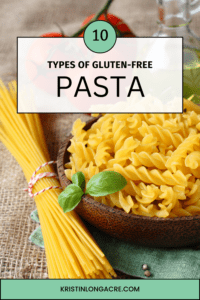Gluten-free pasta isn’t as awful as it sounds. There is this common misconception that when you go gluten-free, you have to give up all of your favorite carbs, such as bread, pasta, cookies, and more.
That’s false!
In the gluten-free community, we love pasta! Just because you can’t enjoy gluten anymore doesn’t mean you’re stuck with eating nothing but cardboard. The cardboard probably has gluten in it, too 😜.
As you get further into your gluten-free journey, you will realize that there are gluten-free options that are just as tasty, and over time, you will come to appreciate the taste, knowing that you won’t wake up miserable the next day.
Does Gluten-Free Pasta Taste The Same As Regular Pasta?
No, but they’re not the same ingredients, so they shouldn’t taste the same. It is made with a different type of flour. To be considered a gluten-free food means it won’t contain wheat, barley, rye, or any variation of that.
Therefore, they won’t taste the same as a gluten-filled pasta does.
For many people, the taste is a shock at first. Chances are it’s because they didn’t realize that the different ingredients meant it would likely have a different taste and texture. The key is finding what type you like best.
Types of Gluten-Free Pasta
There are so many types of gluten-free pasta available. Don’t give up after trying your first type. Each one cooks a little bit differently, tastes a little bit different, and mixes with different types of meals.
Brown Rice Pasta: Made from brown rice flour, it has a similar texture to traditional wheat pasta.
Quinoa Pasta: Quinoa pasta is crafted from quinoa flour and provides a nutty flavor and a good protein dose.
Corn Pasta: Made from corn flour, this pasta has a slightly different taste and texture than wheat pasta.
Chickpea Pasta: Chickpea flour is the main ingredient, offering a higher protein content and a distinct taste. Be careful how much you eat the first time you try it. Chickpeas often leave their mark on your stomach.
Lentil Pasta: Lentil pasta is protein-rich and often has a firmer texture, making it nutritious.
Buckwheat Noodles: Despite the name, buckwheat is gluten-free, and its noodles have a unique flavor.
Sorghum Pasta: Sorghum flour is used to create pasta with a mild flavor and a texture similar to wheat pasta.
Cassava Flour Pasta: Cassava flour, derived from the cassava root, makes gluten-free pasta with a neutral taste.
Almond Flour Pasta: Almond flour is a gluten-free alternative that imparts a nutty flavor to the pasta.
Millet Pasta: Millet flour creates a slightly sweet and mild flavor.
How To Cook Gluten-Free Pasta
For starters, always make sure to read the directions on the box. There will be different directions due to the different types of ingredients in each of the other pastas.
My secret to cooking gluten-free pasta is to undercook it a little bit. It will be perfect.
Download our Going Gluten-Free: Making Your Grocery List eBook to find the different types of gluten-free pasta. Inside, you will learn where to shop, what to buy, and how to plan.
ABOUT ME

Hey There, I’m Kristin, a gluten-free nutrition coach helping gluten-free families adjust to their new lifestyle.


